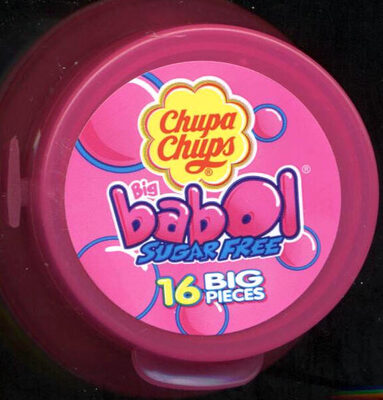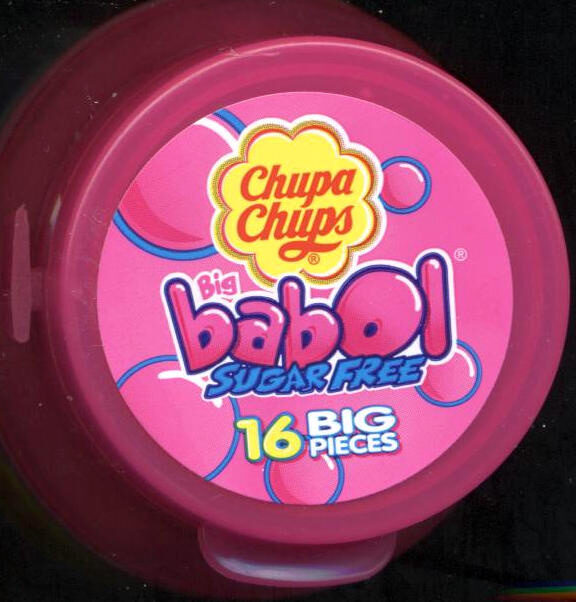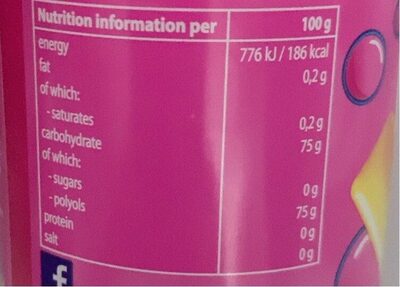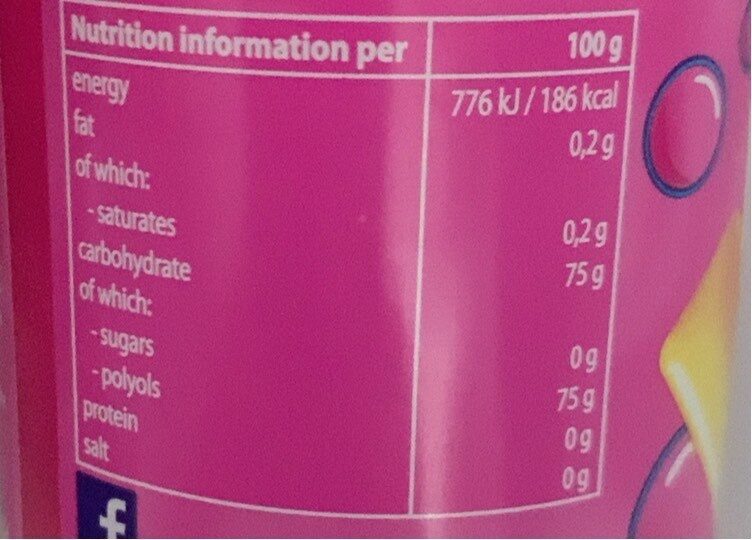Ajuda'ns a fer que la transparència alimentària sigui la norma!
Com a organització sense ànim de lucre, depenem de les vostres donacions per continuar informant els consumidors de tot el món sobre tot allò què mengen.
La revolució alimentària comença amb tu!
Chupa Chups - Big Babol -Sugar Free - 16 Big Pieces - 64 g (16 x 4 g)
Chupa Chups - Big Babol -Sugar Free - 16 Big Pieces - 64 g (16 x 4 g)
Aquesta pàgina del producte no està completa. Podeu ajudar a completar-la editant-la i afegint-hi més dades a partir de les fotos ja disponibles, o fent-ne més amb l'aplicació de androide o iPhone / iPad. Gràcies!
×
Codi de barres: 8003440991206 (EAN / EAN-13)
Nom comú: Bubble gum with sweeteners, strawberry, orange and lemon flavour
Quantitat: 64 g (16 x 4 g)
Empaquetament: Plàstic, en:Bottle or vial, PP 5 - polipropilè, en:Label, en:Vial
Marques: Chupa Chups, Perfetti Van Melle
Categories: Snacks, Aperitius dolços, Llaminadures, Xiclets, en:Sugar-free chewing gum
Etiquetes, certificacions, premis:
Sense o baix en sucre, Punt verd, Sense sucre, Amb edulcorants, Tidy man, Triman

Origen dels ingredients: No especificat
Botigues: Action
Matching with your preferences
Salut
Ingredients
-
33 ingredients
: Sweeteners (isomalt, sorbitol, maltitol, xylitol, maltitol syrup, aspartame, acesulfame K), gum base, flavourings, acid (citric acid), stabiliser (glycerol), maltodextrin, emulsifier (soya lecithin, sucrose esters of fatty acids), thickener (gum arabic), fruit juice powder 0.2% (orange, lemon), coconut fat, strawberry juice concentrate 0.15%, antioxidant (E321), colours (carmines, curcumin, beta - carotene), glazing agent (carnauba wax).Al·lèrgens: en:Orange, en:Soybeans
Processament d'aliments
-
Aliments ultra processats
Elements que indiquen que el producte està al grup 4 - Aliments i begudes ultraprocessats:
- Additiu: E100 - Curcumina
- Additiu: E120 - Carmí
- Additiu: E160a - Carotè
- Additiu: E322 - Lecitines
- Additiu: E414 - Goma aràbiga
- Additiu: E420 - Sorbitol
- Additiu: E422 - Glicerol
- Additiu: E473 - Sucroèster d'àcids grassos
- Additiu: E903 - Cera de carnauba
- Additiu: E950 - Acesulfam K
- Additiu: E951 - Aspartam
- Additiu: E953 - Isomalt
- Additiu: E965 - Maltitol
- Additiu: E967 - Xilitol
- Ingredient: Color
- Ingredient: Emulsionant
- Ingredient: Aromes
- Ingredient: Agent de recobriment
- Ingredient: Maltodextrina
- Ingredient: Edulcorant
- Ingredient: Espessidor
Els productes alimentaris es classifiquen en 4 grups segons el seu grau de processament:
- Aliments no processats o mínimament processats
- Ingredients culinaris processats
- Aliments processats
- Aliments ultra processats
La determinació del grup es fa en funció de la categoria del producte i dels ingredients que conté.
Additius
-
E120 - Carmí
Carminic acid: Carminic acid -C22H20O13- is a red glucosidal hydroxyanthrapurin that occurs naturally in some scale insects, such as the cochineal, Armenian cochineal, and Polish cochineal. The insects produce the acid as a deterrent to predators. An aluminum salt of carminic acid is the coloring agent in carmine. Synonyms are C.I. 75470 and C.I. Natural Red 4. The chemical structure of carminic acid consists of a core anthraquinone structure linked to a glucose sugar unit. Carminic acid was first synthesized in the laboratory by organic chemists in 1991.Origen: Wikipedia (Anglès)
-
E160a - Carotè
Carotene: The term carotene -also carotin, from the Latin carota, "carrot"- is used for many related unsaturated hydrocarbon substances having the formula C40Hx, which are synthesized by plants but in general cannot be made by animals -with the exception of some aphids and spider mites which acquired the synthesizing genes from fungi-. Carotenes are photosynthetic pigments important for photosynthesis. Carotenes contain no oxygen atoms. They absorb ultraviolet, violet, and blue light and scatter orange or red light, and -in low concentrations- yellow light. Carotenes are responsible for the orange colour of the carrot, for which this class of chemicals is named, and for the colours of many other fruits, vegetables and fungi -for example, sweet potatoes, chanterelle and orange cantaloupe melon-. Carotenes are also responsible for the orange -but not all of the yellow- colours in dry foliage. They also -in lower concentrations- impart the yellow coloration to milk-fat and butter. Omnivorous animal species which are relatively poor converters of coloured dietary carotenoids to colourless retinoids have yellowed-coloured body fat, as a result of the carotenoid retention from the vegetable portion of their diet. The typical yellow-coloured fat of humans and chickens is a result of fat storage of carotenes from their diets. Carotenes contribute to photosynthesis by transmitting the light energy they absorb to chlorophyll. They also protect plant tissues by helping to absorb the energy from singlet oxygen, an excited form of the oxygen molecule O2 which is formed during photosynthesis. β-Carotene is composed of two retinyl groups, and is broken down in the mucosa of the human small intestine by β-carotene 15‚15'-monooxygenase to retinal, a form of vitamin A. β-Carotene can be stored in the liver and body fat and converted to retinal as needed, thus making it a form of vitamin A for humans and some other mammals. The carotenes α-carotene and γ-carotene, due to their single retinyl group -β-ionone ring-, also have some vitamin A activity -though less than β-carotene-, as does the xanthophyll carotenoid β-cryptoxanthin. All other carotenoids, including lycopene, have no beta-ring and thus no vitamin A activity -although they may have antioxidant activity and thus biological activity in other ways-. Animal species differ greatly in their ability to convert retinyl -beta-ionone- containing carotenoids to retinals. Carnivores in general are poor converters of dietary ionone-containing carotenoids. Pure carnivores such as ferrets lack β-carotene 15‚15'-monooxygenase and cannot convert any carotenoids to retinals at all -resulting in carotenes not being a form of vitamin A for this species-; while cats can convert a trace of β-carotene to retinol, although the amount is totally insufficient for meeting their daily retinol needs.Origen: Wikipedia (Anglès)
-
E160ai
Beta-Carotene: β-Carotene is an organic, strongly colored red-orange pigment abundant in plants and fruits. It is a member of the carotenes, which are terpenoids -isoprenoids-, synthesized biochemically from eight isoprene units and thus having 40 carbons. Among the carotenes, β-carotene is distinguished by having beta-rings at both ends of the molecule. β-Carotene is biosynthesized from geranylgeranyl pyrophosphate.β-Carotene is the most common form of carotene in plants. When used as a food coloring, it has the E number E160a. The structure was deduced by Karrer et al. in 1930. In nature, β-carotene is a precursor -inactive form- to vitamin A via the action of beta-carotene 15‚15'-monooxygenase.Isolation of β-carotene from fruits abundant in carotenoids is commonly done using column chromatography. It can also be extracted from the beta-carotene rich algae, Dunaliella salina. The separation of β-carotene from the mixture of other carotenoids is based on the polarity of a compound. β-Carotene is a non-polar compound, so it is separated with a non-polar solvent such as hexane. Being highly conjugated, it is deeply colored, and as a hydrocarbon lacking functional groups, it is very lipophilic.Origen: Wikipedia (Anglès)
-
E321 - Butilhidroxitoluè
Butylated hydroxytoluene: Butylated hydroxytoluene -BHT-, also known as dibutylhydroxytoluene, is a lipophilic organic compound, chemically a derivative of phenol, that is useful for its antioxidant properties. European and U.S. regulations allow small amounts to be used as a food additive. In addition to this use, BHT is widely used to prevent oxidation in fluids -e.g. fuel, oil- and other materials where free radicals must be controlled.Origen: Wikipedia (Anglès)
-
E322 - Lecitines
Lecithin: Lecithin -UK: , US: , from the Greek lekithos, "egg yolk"- is a generic term to designate any group of yellow-brownish fatty substances occurring in animal and plant tissues, which are amphiphilic – they attract both water and fatty substances -and so are both hydrophilic and lipophilic-, and are used for smoothing food textures, dissolving powders -emulsifying-, homogenizing liquid mixtures, and repelling sticking materials.Lecithins are mixtures of glycerophospholipids including phosphatidylcholine, phosphatidylethanolamine, phosphatidylinositol, phosphatidylserine, and phosphatidic acid.Lecithin was first isolated in 1845 by the French chemist and pharmacist Theodore Gobley. In 1850, he named the phosphatidylcholine lécithine. Gobley originally isolated lecithin from egg yolk—λέκιθος lekithos is "egg yolk" in Ancient Greek—and established the complete chemical formula of phosphatidylcholine in 1874; in between, he had demonstrated the presence of lecithin in a variety of biological matters, including venous blood, in human lungs, bile, human brain tissue, fish eggs, fish roe, and chicken and sheep brain. Lecithin can easily be extracted chemically using solvents such as hexane, ethanol, acetone, petroleum ether, benzene, etc., or extraction can be done mechanically. It is usually available from sources such as soybeans, eggs, milk, marine sources, rapeseed, cottonseed, and sunflower. It has low solubility in water, but is an excellent emulsifier. In aqueous solution, its phospholipids can form either liposomes, bilayer sheets, micelles, or lamellar structures, depending on hydration and temperature. This results in a type of surfactant that usually is classified as amphipathic. Lecithin is sold as a food additive and dietary supplement. In cooking, it is sometimes used as an emulsifier and to prevent sticking, for example in nonstick cooking spray.Origen: Wikipedia (Anglès)
-
E322i - Lecitina
Lecithin: Lecithin -UK: , US: , from the Greek lekithos, "egg yolk"- is a generic term to designate any group of yellow-brownish fatty substances occurring in animal and plant tissues, which are amphiphilic – they attract both water and fatty substances -and so are both hydrophilic and lipophilic-, and are used for smoothing food textures, dissolving powders -emulsifying-, homogenizing liquid mixtures, and repelling sticking materials.Lecithins are mixtures of glycerophospholipids including phosphatidylcholine, phosphatidylethanolamine, phosphatidylinositol, phosphatidylserine, and phosphatidic acid.Lecithin was first isolated in 1845 by the French chemist and pharmacist Theodore Gobley. In 1850, he named the phosphatidylcholine lécithine. Gobley originally isolated lecithin from egg yolk—λέκιθος lekithos is "egg yolk" in Ancient Greek—and established the complete chemical formula of phosphatidylcholine in 1874; in between, he had demonstrated the presence of lecithin in a variety of biological matters, including venous blood, in human lungs, bile, human brain tissue, fish eggs, fish roe, and chicken and sheep brain. Lecithin can easily be extracted chemically using solvents such as hexane, ethanol, acetone, petroleum ether, benzene, etc., or extraction can be done mechanically. It is usually available from sources such as soybeans, eggs, milk, marine sources, rapeseed, cottonseed, and sunflower. It has low solubility in water, but is an excellent emulsifier. In aqueous solution, its phospholipids can form either liposomes, bilayer sheets, micelles, or lamellar structures, depending on hydration and temperature. This results in a type of surfactant that usually is classified as amphipathic. Lecithin is sold as a food additive and dietary supplement. In cooking, it is sometimes used as an emulsifier and to prevent sticking, for example in nonstick cooking spray.Origen: Wikipedia (Anglès)
-
E330 - Acid citric
Citric acid: Citric acid is a weak organic acid that has the chemical formula C6H8O7. It occurs naturally in citrus fruits. In biochemistry, it is an intermediate in the citric acid cycle, which occurs in the metabolism of all aerobic organisms. More than a million tons of citric acid are manufactured every year. It is used widely as an acidifier, as a flavoring and chelating agent.A citrate is a derivative of citric acid; that is, the salts, esters, and the polyatomic anion found in solution. An example of the former, a salt is trisodium citrate; an ester is triethyl citrate. When part of a salt, the formula of the citrate ion is written as C6H5O3−7 or C3H5O-COO-3−3.Origen: Wikipedia (Anglès)
-
E414 - Goma aràbiga
Gum arabic: Gum arabic, also known as acacia gum, arabic gum, gum acacia, acacia, Senegal gum and Indian gum, and by other names, is a natural gum consisting of the hardened sap of various species of the acacia tree. Originally, gum arabic was collected from Acacia nilotica which was called the "gum arabic tree"; in the present day, gum arabic is collected from acacia species, predominantly Acacia senegal and Vachellia -Acacia- seyal; the term "gum arabic" does not indicate a particular botanical source. In a few cases so‐called "gum arabic" may not even have been collected from Acacia species, but may originate from Combretum, Albizia or some other genus. Producers harvest the gum commercially from wild trees, mostly in Sudan -80%- and throughout the Sahel, from Senegal to Somalia—though it is historically cultivated in Arabia and West Asia. Gum arabic is a complex mixture of glycoproteins and polysaccharides. It is the original source of the sugars arabinose and ribose, both of which were first discovered and isolated from it, and are named after it. Gum arabic is soluble in water. It is edible, and used primarily in the food industry as a stabilizer, with EU E number E414. Gum arabic is a key ingredient in traditional lithography and is used in printing, paint production, glue, cosmetics and various industrial applications, including viscosity control in inks and in textile industries, though less expensive materials compete with it for many of these roles. While gum arabic is now produced throughout the African Sahel, it is still harvested and used in the Middle East.Origen: Wikipedia (Anglès)
-
E420 - Sorbitol
Sorbitol: Sorbitol --, less commonly known as glucitol --, is a sugar alcohol with a sweet taste which the human body metabolizes slowly. It can be obtained by reduction of glucose, which changes the aldehyde group to a hydroxyl group. Most sorbitol is made from corn syrup, but it is also found in nature, for example in apples, pears, peaches, and prunes. It is converted to fructose by sorbitol-6-phosphate 2-dehydrogenase. Sorbitol is an isomer of mannitol, another sugar alcohol; the two differ only in the orientation of the hydroxyl group on carbon 2. While similar, the two sugar alcohols have very different sources in nature, melting points, and uses.Origen: Wikipedia (Anglès)
-
E422 - Glicerol
Glycerol: Glycerol -; also called glycerine or glycerin; see spelling differences- is a simple polyol compound. It is a colorless, odorless, viscous liquid that is sweet-tasting and non-toxic. The glycerol backbone is found in all lipids known as triglycerides. It is widely used in the food industry as a sweetener and humectant and in pharmaceutical formulations. Glycerol has three hydroxyl groups that are responsible for its solubility in water and its hygroscopic nature.Origen: Wikipedia (Anglès)
-
E903 - Cera de carnauba
Carnauba wax: Carnauba -; Portuguese: carnaúba [kaʁnɐˈubɐ]-, also called Brazil wax and palm wax, is a wax of the leaves of the palm Copernicia prunifera -Synonym: Copernicia cerifera-, a plant native to and grown only in the northeastern Brazilian states of Piauí, Ceará, Maranhão, Bahia, and Rio Grande do Norte. It is known as "queen of waxes" and in its pure state, usually comes in the form of hard yellow-brown flakes. It is obtained from the leaves of the carnauba palm by collecting and drying them, beating them to loosen the wax, then refining and bleaching the wax.Origen: Wikipedia (Anglès)
-
E950 - Acesulfam K
Acesulfame potassium: Acesulfame potassium - AY-see-SUL-faym-, also known as acesulfame K -K is the symbol for potassium- or Ace K, is a calorie-free sugar substitute -artificial sweetener- often marketed under the trade names Sunett and Sweet One. In the European Union, it is known under the E number -additive code- E950. It was discovered accidentally in 1967 by German chemist Karl Clauss at Hoechst AG -now Nutrinova-. In chemical structure, acesulfame potassium is the potassium salt of 6-methyl-1‚2,3-oxathiazine-4-3H--one 2‚2-dioxide. It is a white crystalline powder with molecular formula C4H4KNO4S and a molecular weight of 201.24 g/mol.Origen: Wikipedia (Anglès)
-
E951 - Aspartam
Aspartame: Aspartame -APM- is an artificial non-saccharide sweetener used as a sugar substitute in some foods and beverages. In the European Union, it is codified as E951. Aspartame is a methyl ester of the aspartic acid/phenylalanine dipeptide. A panel of experts set up by the European Food Safety Authority concluded in 2013 that aspartame is safe for human consumption at current levels of exposure. As of 2018, evidence does not support a long-term benefit for weight loss or in diabetes. Because its breakdown products include phenylalanine, people with the genetic condition phenylketonuria -PKU- must be aware of this as an additional source.It was first sold under the brand name NutraSweet. It was first made in 1965, and the patent expired in 1992. It was initially approved for use in food products by the U.S. Food and Drug Administration -FDA- in 1981. The safety of aspartame has been the subject of several political and medical controversies, United States congressional hearings, and Internet hoaxes.Origen: Wikipedia (Anglès)
-
E953 - Isomalt
Isomalt: Isomalt is a sugar substitute, a type of sugar alcohol used primarily for its sugar-like physical properties. It has little to no impact on blood sugar levels, and does not stimulate the release of insulin. It also does not promote tooth decay, i.e. is tooth-friendly. Its energy value is 2 kcal/g, half that of sugars. However, like most sugar alcohols, it carries a risk of gastric distress, including flatulence and diarrhea, when consumed in large quantities -above about 20-30 g per day-. Isomalt may prove upsetting to the intestinal tract because it is incompletely absorbed in the small intestine, and when polyols pass into the large intestine, they can cause osmotically induced diarrhea and stimulate the gut flora, causing flatulence. As with other dietary fibers, regular consumption of isomalt can lead to desensitisation, decreasing the risk of intestinal upset. Isomalt can be blended with high-intensity sweeteners such as sucralose, giving a mixture that has the same sweetness as sugar. Isomalt is an equimolar mixture of two mutually diastereomeric disaccharides, each composed of two sugars: glucose and mannitol -α-D-glucopyranosido-1‚6-mannitol- and also glucose and sorbitol -α-D-glucopyranosido-1‚6-sorbitol-. Complete hydrolysis of isomalt yields glucose -50%-, sorbitol -25%-, and mannitol -25%-. It is an odorless, white, crystalline substance containing about 5% water of crystallisation. Isomalt has a minimal cooling effect -positive heat of solution-, lower than many other sugar alcohols, in particular, xylitol and erythritol. Isomalt is manufactured in a two-stage process in which sucrose is first transformed into isomaltulose, a reducing disaccharide -6-O-α-D-glucopyranosido-D-fructose-. The isomaltulose is then hydrogenated, using a Raney nickel catalyst. The final product — isomalt — is an equimolar composition of 6-O-α-D-glucopyranosido-D-sorbitol -1‚6-GPS- and 1-O-α-D-glucopyranosido-D-mannitol-dihydrate -1‚1-GPM-dihydrate-. Isomalt has been approved for use in the United States since 1990. It is also permitted for use in Australia, New Zealand, Canada, Mexico, Iran, the European Union, and other countries. Isomalt is widely used for the production of sugar-free candy, especially hard-boiled candy, because it resists crystallisation much better than the standard combinations of sucrose and corn syrup. It is used in sugar sculpture for the same reason.Origen: Wikipedia (Anglès)
-
E965 - Maltitol
Maltitol: Maltitol is a sugar alcohol -a polyol- used as a sugar substitute. It has 75–90% of the sweetness of sucrose -table sugar- and nearly identical properties, except for browning. It is used to replace table sugar because it is half as caloric, does not promote tooth decay, and has a somewhat lesser effect on blood glucose. In chemical terms, maltitol is known as 4-O-α-glucopyranosyl-D-sorbitol. It is used in commercial products under trade names such as Lesys, Maltisweet and SweetPearl.Origen: Wikipedia (Anglès)
-
E965ii
Maltitol: Maltitol is a sugar alcohol -a polyol- used as a sugar substitute. It has 75–90% of the sweetness of sucrose -table sugar- and nearly identical properties, except for browning. It is used to replace table sugar because it is half as caloric, does not promote tooth decay, and has a somewhat lesser effect on blood glucose. In chemical terms, maltitol is known as 4-O-α-glucopyranosyl-D-sorbitol. It is used in commercial products under trade names such as Lesys, Maltisweet and SweetPearl.Origen: Wikipedia (Anglès)
-
E967 - Xilitol
Xylitol: Xylitol is a sugar alcohol used as a sweetener. The name derives from Ancient Greek: ξύλον, xyl[on], "wood" + suffix -itol, used to denote sugar alcohols. Xylitol is categorized as a polyalcohol or sugar alcohol -specifically an alditol-. It has the formula CH2OH-CHOH-3CH2OH. It is a colorless or white solid that is soluble in water. Use of manufactured products containing xylitol may reduce tooth decay.Origen: Wikipedia (Anglès)
Anàlisi dels ingredients
-
Pot contenir oli de palma
Ingredients que poden contenir oli de palma: Beta-carotè
-
No és vegà
Ingredients no vegans: E120
-
No és vegetarià
Ingredients no vegetarians: E120
-
Detalls de l'anàlisi dels ingredients
: Sweeteners (isomalt, sorbitol, maltitol, xylitol, maltitol syrup, aspartame, acesulfame K), gum base, flavourings, acid (citric acid), stabiliser (glycerol), maltodextrin, emulsifier (soya lecithin, sucrose esters of fatty acids), thickener (gum arabic), fruit juice 0.2% (orange, lemon), coconut fat, strawberry juice concentrate 0.15%, antioxidant (e321), colours (carmines, curcumin, beta-carotene), glazing agent (carnauba wax)- Sweeteners -> en:sweetener - percent_min: 19.85 - percent_max: 98.1
- isomalt -> en:e953 - vegan: yes - vegetarian: yes - percent_min: 2.83571428571428 - percent_max: 98.1
- sorbitol -> en:e420 - vegan: yes - vegetarian: yes - percent_min: 0 - percent_max: 49.05
- maltitol -> en:e965 - vegan: yes - vegetarian: yes - percent_min: 0 - percent_max: 32.7
- xylitol -> en:e967 - vegan: yes - vegetarian: yes - percent_min: 0 - percent_max: 24.525
- maltitol syrup -> en:e965ii - vegan: yes - vegetarian: yes - percent_min: 0 - percent_max: 19.62
- aspartame -> en:e951 - vegan: yes - vegetarian: yes - percent_min: 0 - percent_max: 16.35
- acesulfame K -> en:e950 - vegan: yes - vegetarian: yes - percent_min: 0 - percent_max: 14.0142857142857
- gum base -> en:gum-base - percent_min: 0.2 - percent_max: 49.15
- flavourings -> en:flavouring - vegan: maybe - vegetarian: maybe - percent_min: 0.2 - percent_max: 5
- acid -> en:acid - percent_min: 0.2 - percent_max: 5
- citric acid -> en:e330 - vegan: yes - vegetarian: yes - percent_min: 0.2 - percent_max: 5
- stabiliser -> en:stabiliser - percent_min: 0.2 - percent_max: 5
- glycerol -> en:e422 - vegan: maybe - vegetarian: maybe - percent_min: 0.2 - percent_max: 5
- maltodextrin -> en:maltodextrin - vegan: yes - vegetarian: yes - percent_min: 0.2 - percent_max: 5
- emulsifier -> en:emulsifier - percent_min: 0.2 - percent_max: 5
- soya lecithin -> en:soya-lecithin - vegan: yes - vegetarian: yes - ciqual_food_code: 42200 - percent_min: 0 - percent_max: 5
- sucrose esters of fatty acids -> en:e473 - vegan: maybe - vegetarian: maybe - percent_min: 0 - percent_max: 2.5
- thickener -> en:thickener - percent_min: 0.2 - percent_max: 5
- gum arabic -> en:e414 - vegan: yes - vegetarian: yes - percent_min: 0.2 - percent_max: 5
- fruit juice -> en:fruit-juice - vegan: yes - vegetarian: yes - percent_min: 0.2 - percent: 0.2 - percent_max: 0.2
- orange -> en:orange - vegan: yes - vegetarian: yes - ciqual_proxy_food_code: 13034 - percent_min: 0 - percent_max: 0.2
- lemon -> en:lemon - vegan: yes - vegetarian: yes - ciqual_proxy_food_code: 13009 - percent_min: 0 - percent_max: 0.2
- coconut fat -> en:coconut-fat - vegan: yes - vegetarian: yes - from_palm_oil: no - ciqual_food_code: 16040 - percent_min: 0.15 - percent_max: 0.2
- strawberry juice concentrate -> en:strawberry-juice-concentrate - vegan: yes - vegetarian: yes - ciqual_food_code: 13014 - percent_min: 0.15 - percent: 0.15 - percent_max: 0.15
- antioxidant -> en:antioxidant - percent_min: 0 - percent_max: 0.15
- e321 -> en:e321 - vegan: yes - vegetarian: yes - percent_min: 0 - percent_max: 0.15
- colours -> en:colour - percent_min: 0 - percent_max: 0.15
- carmines -> en:e120 - vegan: no - vegetarian: no - percent_min: 0 - percent_max: 0.15
- curcumin -> en:e100 - vegan: yes - vegetarian: yes - percent_min: 0 - percent_max: 0.15
- beta-carotene -> en:e160ai - vegan: maybe - vegetarian: maybe - from_palm_oil: maybe - percent_min: 0 - percent_max: 0.15
- glazing agent -> en:glazing-agent - percent_min: 0 - percent_max: 0.15
- carnauba wax -> en:e903 - vegan: yes - vegetarian: yes - percent_min: 0 - percent_max: 0.15
- Sweeteners -> en:sweetener - percent_min: 19.85 - percent_max: 98.1
Nutrició
-
Nutri-Score no aplicable
No aplicable a la categoria: Xiclets
⚠ ️Nutri-Score no s'aplica a aquesta categoria de producte.Podries afegir la informació necessària per calcular el Nutri-Score?
-
Nivells de nutrients
-
Greix en baixa quantitat (0.2%)
Què us cal saber- Un alt consum de greixos, especialment de greixos saturats, pot augmentar el colesterol, que augmenta el risc de patir malalties del cor.
Recomanació: Reduïu el consum de greixos i greixos saturats- Trieu productes amb menys greixos i greixos saturats.
-
Àcid gras saturat en baixa quantitat (0.2%)
Què us cal saber- Un alt consum de greixos, especialment de greixos saturats, pot augmentar el colesterol, que augmenta el risc de patir malalties del cor.
Recomanació: Reduïu el consum de greixos i greixos saturats- Trieu productes amb menys greixos i greixos saturats.
-
Sucre en baixa quantitat (0%)
Què us cal saber- Un alt consum de sucre pot provocar augment de pes i càries dental. També augmenta el risc de patir diabetis tipus 2 i malalties cardiovasculars.
Recomanació: Limitau el consum de sucre i de begudes ensucrades- Les begudes ensucrades (com ara refrescos, begudes de fruites i sucs i nèctars de fruites) s'han de limitar tant com sigui possible (no més d'1 got al dia).
- Triau productes amb menor contingut de sucre i reduïu el consum de productes amb sucres afegits.
-
Sal comuna en baixa quantitat (0.02%)
Què us cal saber- Un alt consum de sal (o sodi) pot provocar un augment de la pressió arterial, que pot augmentar el risc de patir malalties del cor i ictus.
- Moltes persones que tenen hipertensió no ho saben, ja que sovint no en tenen símptomes.
- La majoria de la gent consumeix massa sal (de 9 a 12 grams de mitjana al dia), al voltant del doble del nivell màxim d'ingesta recomanat.
Recomanació: Limitau la ingesta de sal i d'aliments rics en sal- Reduïu la sal que emprau quan cuinau, i no afegiu sal a taula.
- Limiteu el consum d'aperitius salats i trieu productes amb menor contingut de sal.
-
-
Informació nutricional
Informació nutricional Com es ven
per 100 g/100 mlCom es ven
per porció (4 g)Comparat amb: en:Sugar-free chewing gum Energia 784 kj
(188 kcal)31,4 kj
(7 kcal)+14% Greix 0,2 g 0,008 g -26% Àcid gras saturat 0,2 g 0,008 g +89% Hidrats de carboni 76 g 3,04 g +15% Sucre 0 g 0 g -100% Polyols 75 g 3 g +13% Fiber ? ? Proteïna 0 g 0 g -100% Sal comuna 0,02 g 0,001 g +18% Alcohol 0 % vol 0 % vol Fruits‚ vegetables‚ nuts and rapeseed‚ walnut and olive oils (estimate from ingredients list analysis) 0,35 % 0,35 %
Entorn
-
Puntuació ecològica no calculada - Impacte ambiental desconegut
No hem pogut calcular l'Eco-Score d'aquest producte perquè li falten algunes dades, podríeu ajudar-nos a completar-lo?Podries afegir una categoria del producte més precisa perquè puguem calcular l'Eco-Score? Afegir una categoria
Empaquetament
-
Embalatge d'impacte mitjà
-
Peces d'embalatge
1 x Vial 64 g (PP 5 - polipropilè)
-
Materials d'embalatge
Material % Pes de l'embalatge Pes de l'embalatge per 100 g de producte Plàstic
-
Transport
-
Orígens dels ingredients
Orígens dels ingredients amb impacte alt
Origen del producte i / o dels seus ingredients % d'ingredients Impacte No especificat 100 %Alt
Report a problem
-
Incomplete or incorrect information?
Category, labels, ingredients, allergens, nutritional information, photos etc.
If the information does not match the information on the packaging, please complete or correct it. Open Food Facts is a collaborative database, and every contribution is useful for all.
Fonts de dades
Producte afegit per kiliweb
Última modificació de la pàgina del producte per bugmenot.
La pàgina del producte, també editada per halal-app-chakib, inf, openfoodfacts-contributors, packbot, roboto-app, saramikaela, swipe-studio, telperion87, thaialagata, thierrymonisha-gmail-com, yuka.DLAbEtqnOP4DPMLLi9lp7BeWKff8KPwIIlUnog, yuka.ZXFSWU9mbFl2NmRia2ZFeTFSN2I2dlFzeUs2WlJXZUpEczBNSVE9PQ, yuka.sY2b0xO6T85zoF3NwEKvlhEZUIfPrw6cDyLVsnKam_zWBIGyeIx03Y3LLKs, yuka.sY2b0xO6T85zoF3NwEKvlkoddNrvsAnaCy3UiGqQ4_mwL6zGOMt5va_iaao, yuka.sY2b0xO6T85zoF3NwEKvllxWdIXxiCj5DDPghheE6NqJCszZWPcv6YzIA6s, yuka.sY2b0xO6T85zoF3NwEKvln16dvXRi2mfDTflpm2Cy_aMD6W2Rd1-s9TlEas, yuka.sY2b0xO6T85zoF3NwEKvlnIYQoflqTXjHBHipX2JwI3UEcHjf-1b0LTBNKs.









